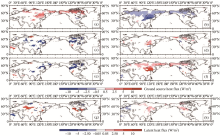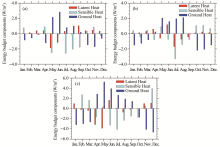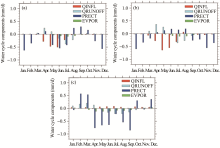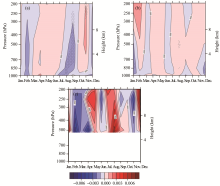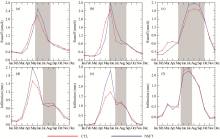Sciences in Cold and Arid Regions ›› 2021, Vol. 13 ›› Issue (1): 18–29.doi: 10.3724/SP.J.1226.2021.20059
Simulated effect of soil freeze-thaw process on surface hydrologic and thermal fluxes in frozen ground region of the Northern Hemisphere
Di Ma1,2,SiQiong Luo1( ),DongLin Guo3,ShiHua Lyu4,1,XianHong Meng1,BoLi Chen5,LiHui Luo6
),DongLin Guo3,ShiHua Lyu4,1,XianHong Meng1,BoLi Chen5,LiHui Luo6
- 1.Key Laboratory for Land Surface Process and Climate Change in Cold and Arid Regions, Northwest Institute of Eco-Environment and Resources, Chinese Academy of Science, Lanzhou, Gansu 730000, China
2.College of Atmospheric Sciences, Lanzhou University, Lanzhou, Gansu 730000, China
3.Nansen-Zhu International Research Center, Institute of Atmospheric Physics, Chinese Academy of Sciences, Beijing 100029, China
4.School of Atmospheric Sciences, Plateau Atmosphere and Environment Key Laboratory of Sichuan Province, Chengdu University of Information Technology, Chengdu, Sichuan 610225, China
5.Changzhou Meteorological Bureau, Changzhou, Jiangsu 213000, China
6.State Key Laboratory of Frozen Soils Engineering, Northwest Institute of Eco-Environment and Resources, Chinese Academy of Sciences, Lanzhou, Gansu 730000, China
|
Burke EJ, Jones CD, Koven CD, 2013. Estimating the permafrost-carbon climate response in the CMIP5 Climate Models using a simplified approach. Journal of Climate, 26(14): 4897-4909. DOI: 10.1175/Jcli-D-12-00550.1.
doi: 10.1175/Jcli-D-12-00550.1 |
|
|
Chen BL, Luo SQ, Lu SH, et al., 2014. Effects of the soil freeze-thaw process on the regional climate of the Qinghai-Tibet Plateau. Climate Research, 59(3): 243-257. DOI: 10. 3354/cr01217.
doi: 10. 3354/cr01217 |
|
|
Collins WD, Bitz CM, Blackmon ML, et al., 2006. The Community Climate System Model version 3 (CCSM3). Journal of Climate, 19(11): 2122-2143. DOI: 10.1175/JCLI3761.1.
doi: 10.1175/JCLI3761.1 |
|
|
Cuo L, Zhang YX, Bohn TJ, et al., 2015. Frozen soil degradation and its effects on surface hydrology in the northern Tibetan Plateau. Journal of Geophysical Research-Atmospheres, 120(16): 8276-8298. DOI: 10.1002/2015jd023193.
doi: 10.1002/2015jd023193 |
|
|
Flanner MG, Zender CS, Randerson JT, et al., 2007. Present-day climate forcing and response from black carbon in snow. Journal of Geophysical Research-Atmospheres, 112(D11): 1-17. DOI: 10.1029/2006jd008003.
doi: 10.1029/2006jd008003 |
|
|
Guo DL, Sun JQ, 2015. Permafrost thaw and associated settlement hazard onset timing over the Qinghai-Tibet Engineering Corridor. International Journal of Disaster Risk Science, 6(4): 347-358. DOI: 10.1007/s13753-015-0072-3.
doi: 10.1007/s13753-015-0072-3 |
|
|
Guo DL, Wang HJ, 2016. CMIP5 permafrost degradation projection: A comparison among different regions. Journal of Geophysical Research-Atmospheres, 121(9): 4499-4517. DOI: 10.1002/2015jd024108.
doi: 10.1002/2015jd024108 |
|
|
Guo DL, Yang MX, Wang HJ, 2011a. Characteristics of land surface heat and water exchange under different soil freeze/thaw conditions over the central Tibetan Plateau. Hydrological Processes, 25(16): 2531-2541. DOI: 10.1002/hyp.8025.
doi: 10.1002/hyp.8025 |
|
|
Guo DL, Yang MX, Wang HJ, 2011b. Sensible and latent heat flux response to diurnal variation in soil surface temperature and moisture under different freeze/thaw soil conditions in the seasonal frozen soil region of the central Tibetan Plateau. Environmental Earth Sciences, 63(1): 97-107. DOI: 10.1007/s12665-010-0672-6.
doi: 10.1007/s12665-010-0672-6 |
|
|
Ishikawa M, Zhang YS, Kadota T, et al., 2006. Hydrothermal regimes of the dry active layer. Water Resources Research, 42(4): 1-10. DOI: 10.1029/2005wr004200.
doi: 10.1029/2005wr004200 |
|
|
Koven CD, Chambers JQ, Georgiou K, et al., 2015. Controls on terrestrial carbon feedbacks by productivity versus turnover in the CMIP5 Earth System Models. Biogeosciences, 12(17): 5211-5228. DOI: 10.5194/bg-12-5211-2015.
doi: 10.5194/bg-12-5211-2015 |
|
|
Lachenbruch AH, Marshall BV, 1986. Changing climate: geothermal evidence from permafrost in the alaskan arctic. Science, 234(4777): 689-696. DOI: 10.1126/science.234. 4777.689.
doi: 10.1126/science.234. 4777.689 |
|
|
Lawrence DM, Oleson KW, Flanner MG, et al., 2011. Parameterization Improvements and Functional and Structural Advances in Version 4 of the Community Land Model. Journal of Advances in Modeling Earth Systems, 3: 1-27. DOI: 10.1029/2011ms000045.
doi: 10.1029/2011ms000045 |
|
|
Lawrence DM, Slater AG, Romanovsky VE, et al., 2008. Sensitivity of a model projection of near-surface permafrost degradation to soil column depth and representation of soil organic matter. Journal of Geophysical Research-Earth Surface, 113: F02011. DOI: 10.1029/2007jf000883.
doi: 10.1029/2007jf000883 |
|
| Li SX, Nan Z, Zhao L, 2002a. Impact of soil freezing and thawing process on thermal exchange between atmosphere and ground surface. Journal of Glaciolgy and Geocryology, 24(5): 506-511. (in Chinese) | |
| Li SX, Nan Z, Zhao L, 2002b. Impact of freezing and thawing on energy exchange between the system and environment. Journal of Glaciolgy and Geocryology, 24(2): 109-115. (in Chinese) | |
|
Li X, Jin R, Pan XD, et al., 2012. Changes in the near-surface soil freeze-thaw cycle on the Qinghai-Tibetan Plateau. International Journal of Applied Earth Observation and Geoinformation, 17: 33-42. DOI: 10.1016/j.jag.2011.12.002.
doi: 10.1016/j.jag.2011.12.002 |
|
|
Liljedahl AK, Boike J, Daanen RP, et al., 2016. Pan-Arctic ice-wedge degradation in warming permafrost and its influence on tundra hydrology. Nature Geoscience, 9(4): 312-318. DOI: 10.1038/Ngeo2674.
doi: 10.1038/Ngeo2674 |
|
|
Luo S, Fang X, Lyu S, et al., 2016. Frozen ground temperature trends associated with climate change in the Tibetan Plateau Three River Source Region from 1980 to 2014. Climate Research, 67(3): 241-255. DOI: 10.3354/cr01371.
doi: 10.3354/cr01371 |
|
|
Luo SQ, Fang XW, Lyu SH, et al., 2017. Interdecadal changes in the freeze depth and period of frozen soil on the Three Rivers Source Region in China from 1960 to 2014. Advances in Meteorology, 2017(5): 1-14. DOI: 10.1155/2017/5931467.
doi: 10.1155/2017/5931467 |
|
|
Luo SQ, Lu SH, Zhang Y, 2009. Development and validation of the frozen soil parameterization scheme in Common Land Model. Cold Regions Science and Technology, 55(1): 130-140. DOI: 10.1016/j.coldregions.2008.07.009.
doi: 10.1016/j.coldregions.2008.07.009 |
|
|
Nelson FE, Anisimov OA, Shiklomanov NI, 2001. Subsidence risk from thawing permafrost-The threat to man-made structures across regions in the far north can be monitored. Nature, 410(6831): 889-890. DOI: 10.1038/35073746.
doi: 10.1038/35073746 |
|
|
Poutou E, Krinner G, Genthon C, et al., 2004. Role of soil freezing in future boreal climate change. Climate Dynamics, 23(6): 621-639. DOI: 10.1007/s00382-004-0459-0.
doi: 10.1007/s00382-004-0459-0 |
|
|
Romanovsky VE, Smith SL, Christiansen HH, 2010. Permafrost thermal state in the polar northern hemisphere during the international polar year 2007-2009: a synthesis. Permafrost and Periglacial Processes, 21(2): 106-116. DOI: 10. 1002/ppp.689.
doi: 10. 1002/ppp.689 |
|
|
Sakaguchi K, Zeng XB, 2009. Effects of soil wetness, plant litter, and under-canopy atmospheric stability on ground evaporation in the Community Land Model (CLM3.5). Journal of Geophysical Research-Atmospheres, 114: 1-14. DOI: 10.1029/2008jd010834.
doi: 10.1029/2008jd010834 |
|
|
Schuur EA, McGuire AD, Schadel C, et al., 2015. Climate change and the permafrost carbon feedback. Nature, 520(7546): 171-179. DOI: 10.1038/nature14338.
doi: 10.1038/nature14338 |
|
|
Slater AG, Lawrence DM, 2013. Diagnosing present and future permafrost from climate models. Journal of Climate, 26(15): 5608-5623. DOI: 10.1175/Jcli-D-12-00341.1.
doi: 10.1175/Jcli-D-12-00341.1 |
|
|
Wang GX, Hu HC, Li TB, 2009. The influence of freeze-thaw cycles of active soil layer on surface runoff in a permafrost watershed. Journal of Hydrology, 375(3-4): 438-449. DOI: 10.1016/j.jhydrol.2009.06.046.
doi: 10.1016/j.jhydrol.2009.06.046 |
|
|
Yamazaki Y, Kubota J, Ohata T, et al., 2006. Seasonal changes in runoff characteristics on a permafrost watershed in the southern mountainous region of eastern Siberia. Hydrological Processes, 20(3): 453-467. DOI: 10.1002/hyp.5914.
doi: 10.1002/hyp.5914 |
|
|
Yang MX, Nelson FE, Shiklomanov NI, et al., 2010. Permafrost degradation and its environmental effects on the Tibetan Plateau: A review of recent research. Earth-Science Reviews, 103(1-2): 31-44. DOI: 10.1016/j.earscirev.2010. 07.002.
doi: 10.1016/j.earscirev.2010. 07.002 |
|
|
Yang MX, Yao TD, Gou XH, et al., 2007. Diurnal freeze/thaw cycles of the ground surface on the Tibetan Plateau. Chinese Science Bulletin, 52(1): 136-139. DOI: 10.1007/s11434-007-0004-8.
doi: 10.1007/s11434-007-0004-8 |
|
|
Zeng XB, Decker M, 2009. Improving the numerical solution of soil moisture-based Richards Equation for Land Models with a deep or shallow water table. Journal of Hydrometeorology, 10(1): 308-319. DOI: 10.1175/2008jhm1011.1.
doi: 10.1175/2008jhm1011.1 |
|
|
Zhang T, Barry R, Knowles K, et al., 2008. Statistics and characteristics of permafrost and ground-ice distribution in the Northern Hemisphere. Polar Geography, 31(1-2): 47-68. DOI: 10.1080/10889370802175895.
doi: 10.1080/10889370802175895 |
|
|
Zimov SA, Schuur EA, Chapin FS, 2006. Climate change. Permafrost and the global carbon budget. Science, 312(5780): 1612-1613. DOI: 10.1126/science.1128908.
doi: 10.1126/science.1128908 |
| No related articles found! |









